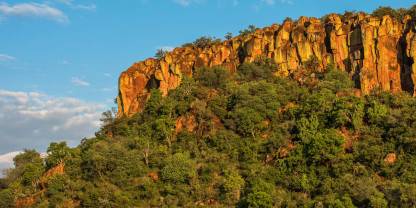Average Expert Rating
Rating Breakdown
Write a User ReviewWaterberg: A Rare-Species Fortress
Occasional sightings of elusive leopard, cheetah and caracal have been recorded in the Waterberg, but it is extremely
Read more
unusual to see lion or wild dog in the park. The absence of lion and elephant, as well as large sectors of the plateau that are buffalo-free, means that keen hikers can undertake a 42km/26mi self-guided trail. This trekking adventure is carefully controlled, and hikers are expected to be self-sufficient. Shelters and water can be found along a well-defined, scenic route, but fires are not permitted. For those visitors who think a marathon-length trek sounds too much like hard work, there are several lodges situated around the Waterberg Plateau as well as the Namibian Wildlife Resorts’ Waterberg Rest Camp inside the park.History and Hiking at Beautiful Waterberg
For me, the highlight of my only visit to this pleasant and picturesque park was the opportunity to hike from our campsite to the top of the sandstone massif, which affords spectacular views across the flat plains surrounding the plateau. In fact, much of the park can be explored on foot, a rare treat in Namibia.
The wildlife here might seem a little underwhelming compared to stalwarts like Etosha, but Waterberg is an important sanctuary for white rhino and rare antelope species such as sable and eland. Leopard and brown hyena are occasionally sighted here, but are generally well-hidden by the dense bush.
If you’re a history buff like me, Waterberg is also significant in this regard. The Battle of Waterberg was the catalyst for the Namibian Genocide of 1904-1909. There is a graveyard and a monument inside the park that give some insight into this bloody chapter of Namibia’s history.
Hiding in the Waterberg
This elevated park is one of the country’s more scenic and unusual wildlife-viewing venues. Looming over the surrounding desert and dense with scrub – so dense it’s difficult to visually penetrate – the park contains some rare beauties. In fact its isolation makes it perfect for otherwise endangered animals, many of whom have been introduced here and have since flourished. There are a couple of well-built animal hides and while crouching down in one gnawing on a lunch pack that comes as part of the wildlife safari (official activities are the only way to see the park), I saw some of southern Africa’s rarest and most beautiful antelope. Firstly, a stately eland made its way into view, cautiously sniffing around the almost dry waterhole. This was followed by a roan and then the magnificent sable with its majestic curved horns and confident swagger – what a treat. If you’re really lucky you may catch sight of leopard, cheetah or brown hyena skulking through nearby bushes.
Waterberg: Wildlife & Walking
You wouldn’t come to Waterberg if you’re on your first safari with dreams of the Big Five. I’ve always thought of Waterberg as something of a niche experience, one that combines the chance to see some much-sought-after species (black and white rhino, as well as sable and roan antelope, and the only buffalo in Namibia apart from the far north) with some of Namibia’s best hiking. Wildlife can be difficult to see (although I did see my first African porcupine here!), but the experience of hiking the high country with fabulous views along the way is why you come here – seeing any of these species is a bonus. I also like Waterberg because once you leave behind the main access roads, crowds are minimal, although the multiday hikes are popular in high season. Terrific accommodation options across a range of budgets are another highlight.
A Flat-Topped Sandstone Plateau Harbouring Unique Species
Namibia’s only mountainous game park, Waterberg owes its name to the springs surfacing on its slopes (berg is Afrikaans for ‘mountain’). It has a crown of lush-green vegetation on top, which I found a refreshing and wonderfully scenic contrast to the monotonous, scrubby plain below. Waterberg Camp was a little bland I thought, but its redeeming features are the views of the sandstone cliffs, and banded mongoose and warthog scurrying around; delightfully bush babies also revealed themselves in the trees at dusk. Self-driving is not permitted, but there are organised game-drives (which also stop at hides) and I enjoyed the peaceful nature trails around camp. In the early 1970s several of Namibia's endangered species were translocated to Waterberg – the sharp barrier of cliffs protects them – and a number have flourished well. I saw roan, sable, kudu and eland, so overall thought it was a great park to see the larger and rarer antelope, but be aware rhino and leopard are known to be elusive and are rarely seen in the thick bush.

